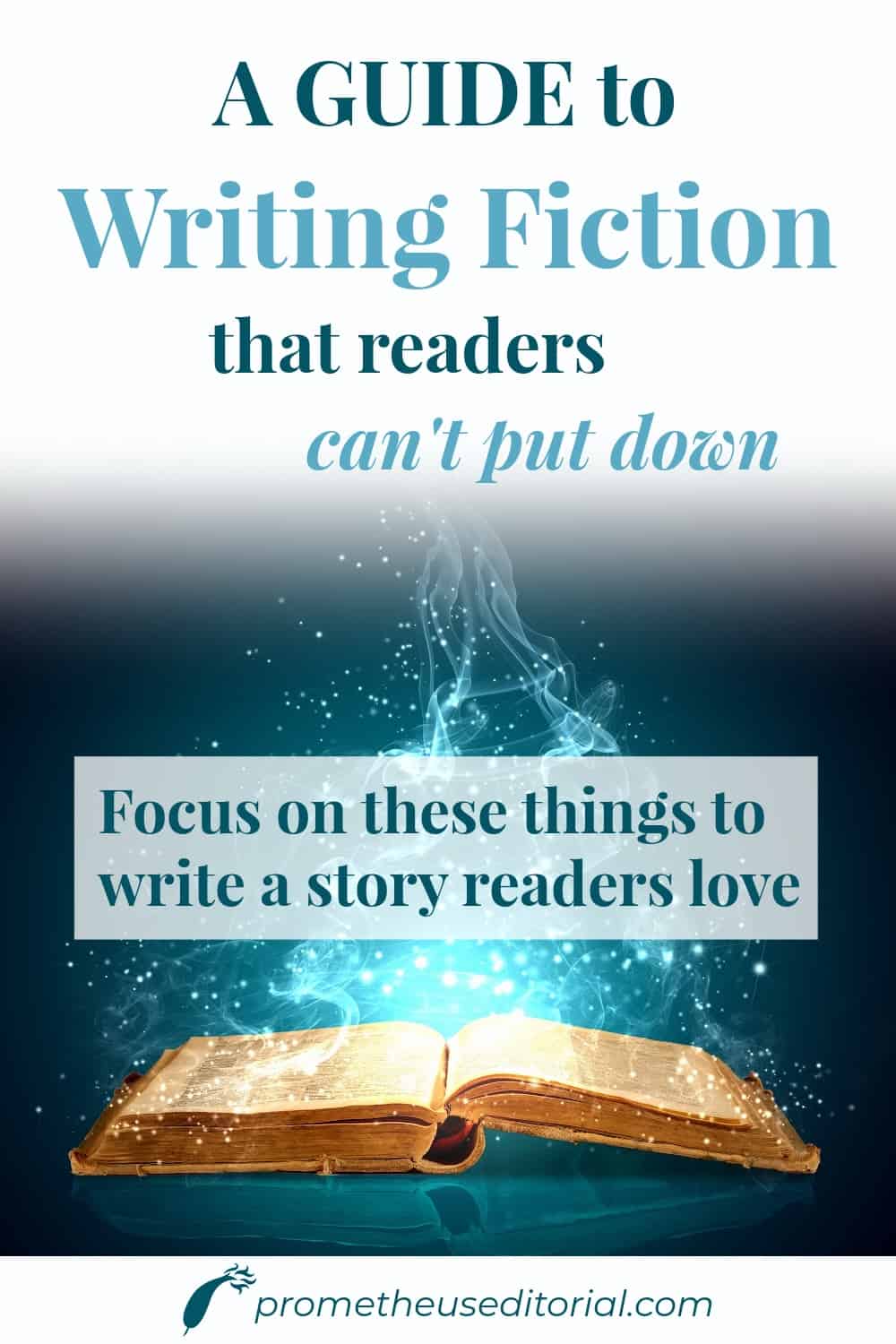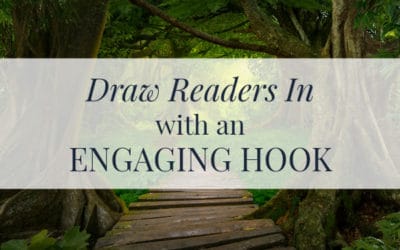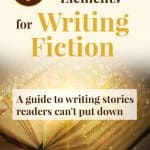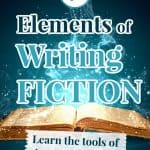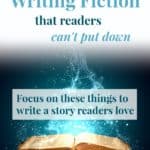The 7 Elements of Fiction
So you’re writing a novel, or maybe you’re thinking about writing one. But how do you know if it’s good? What makes up a good story?
In this article, I’ll be breaking down the 7 elements of fiction: complex characters, point of view, plot, tense, setting, voice, and meaning. These are the things you need to focus on if you want to master the art of storytelling and build a strong foundation of readers who keep coming back.
I’ll walk you through what you need to know about each of them to craft a compelling story that your readers will love just as much as you do.
The 1st Element of Fiction: Complex Characters
If you want to write good fiction, you need to create complex characters that readers will love.
A story is fueled by characters that can draw readers in and keep them engaged. A great character is a character readers can connect with and root for, someone who is interesting and who readers enjoy hearing about.
Complex Characters Are Three Dimensional
Complex characters aren’t all good or all bad. They have to be somewhere in the middle. They have positive qualities as well as negative ones, and this makes them unique and interesting.
If they are the heroes of the story, they have flaws, but they can overcome their flaws. If they are the villains, they have positive qualities as well as negative ones. This will make them more ambiguous, interesting, and unpredictable.
Complex Characters Want Something
Your characters need to have motivations that drive them, both to make them more interesting and to explain why they do the things they do.
Complex Characters Overcome Challenges
Something is stopping the characters from getting what they want, and they need to find a way to do something about it. This is an important driver for the plot.
Complex Characters Grow and Change
Well-developed characters will become different versions of themselves by the time the story is over. At least most of the time.
Sometimes a character will be set in their ways and refuse to change — and this is important to the story as well.
A character who goes on an internal journey throughout the story is more interesting to readers and makes the story more engaging.
Complex Characters Are Relatable
Even villains can have attributes that people can connect with. But this is especially necessary for protagonists.
Readers need to root for your characters and want to know what will happen to them, and this is part of what makes them keep reading your book.
The 2nd Element Fiction: The Right Point of View
To tell the story you want to tell and help readers connect with your characters, you need to choose a point of view that creates the experience you want for your readers.
There is no one right point of view, but there is a point of view that will do the best job of telling your story the way that you want to tell it. It’s important to figure this out as early in the process as possible if you want to avoid extra rewriting later on.
Choosing the Right Narrator
If you want readers to enjoy your story, they need to be able to trust your narrator. A consistent narrator will fade into the background of the reader’s awareness so that they can focus on more important things like your characters and plot.
Even if you choose an unreliable narrator, there has to be a pattern to it and a reason for it to make sense.
Most fiction is written in either first person or third person.
First person is where the main character speaks directly to readers using the pronoun “I.” Third person is where an external narrator tells readers what the main character is doing using the pronouns “he,” “she,” and “they.”
Writing from a First-Person Point of View
First person brings readers closer to the character, and it is limited by the knowledge of the main character.
For example, because it’s the character telling the story, you can only tell readers what that main character knows.
Writing from a Third-Person Point of View
Third person is more flexible because the narrator can know things that the main character doesn’t and might describe the main character from an external perspective, depending on the style of third-person narration.
In third person the reader is less connected to the main character because they are being told about the main character rather than hearing directly from that character. Another way of saying this is that there is greater narrative distance between your readers and your characters.
Third Person Omniscient vs. Third Person Limited
Most modern fiction is written from a third-person limited point of view. This means that the narrator sticks closely to the main character and can often hear their thoughts but not the thoughts of other characters.
Third-person limited is the type of third-person narration with the least narrative distance. If you aren’t sure what point of view to use for your novel, this one is often a good choice.
Third person omniscient is less common these days and harder to sell, though it was more popular in the past and many classics use it. In third person omniscient, the narrator has more distance from the main character, knows a lot outside of that main character’s field of knowledge, and may even tell readers the thoughts of multiple other characters.
These factors create more narrative distance and limit how closely your readers can connect with one specific main character.
If Omniscient, How Omniscient?
Omniscience, like many other things, exists on a spectrum. When choosing this point of view, it is important to pin down how omniscient the narrator will be.
Because it has such a strong influence on the reader’s experience, every aspect of point of view should be intentional.
Make the point of view clear early on and keep it consistent to avoid confusing readers.
Writing in Second Person
Second person is more unusual, but some stories use it. This is when the narrator speaks directly to readers using the second-person pronoun “you.”
The reader becomes the main character in the story and is being told the thoughts and actions of that main character as if the reader is having those thoughts and doing those actions.
Because second person is less common, readers who aren’t used to it can get thrown off and be less willing to read your book. Second person perspectives can also be harder to write since this point of view is less familiar to you than first or third person.
Consistency in Point of View
It’s important to keep your point of view consistent so that you don’t risk confusing your readers. You’re their guide through this story, and you need to be a reliable guide who they can trust.
You can have multiple point-of-view characters as long as you follow a consistent pattern throughout the novel and make point-of-view changes clear to readers.
Don’t change the point of view in the middle of your story unless you have a very good reason that you can clearly articulate to yourself.
The 3rd Element of Fiction: A Compelling Plot
If you want people to keep reading, you need a plot that keeps them enthralled.
The plot is the structure of the story that everything else is built around. A good plot is believable and logically makes sense. At the same time, it should be unpredictable and keep readers wondering what will happen next.
Your plot needs to be paced well, without sections that move too quickly or too slowly.
Above all, it must keep your readers interested throughout the story and conclude in a way that feels satisfying.
A Compelling Plot Is Driven by Conflict
A broad conflict should drive the plot for the length of the story, and smaller conflicts and sub-plots can keep readers on the edge of their seats wondering what is going to happen next.
If there is no conflict and everything goes as planned, your story will struggle to keep readers engaged.
This is also an important thing to remember when you’re writing your blurb. You need to give readers enough conflict in your story that they want to keep reading, and you need to show prospective readers in your blurb what the conflict is that makes your book worth buying.
A Compelling Plot Resolves Its Conflict
A good plot has a resolution. Even if you’re writing a series and leave a few loose ends for later books, it’s important to give readers some kind of resolution.
Readers enjoy seeing events resolve after all the time they’ve spent rooting for your characters.
The ending doesn’t have to be predictable and it doesn’t even have to be a happy ending, but there needs to be a resolution of the main plot arc that forms the basis of your story.
A Compelling Plot is Easy for Readers to Follow
Overcomplicating your plot can make the reader’s job difficult, which makes them less engaged and less willing to keep reading. Sometimes simpler is better.
Subplots are important, but it’s essential to make sure the average reader in your target audience can follow what’s happening without getting lost. Any subplots that you decide to include should strengthen the main plotline rather than compete with it for the reader’s attention.
A Compelling Plot Accomplishes Something
Incorporating broader themes into your plot can make it feel meaningful to readers and get them more invested in your story. This means more than just resolving the original conflict.
Maybe your characters change the world, or maybe they change themselves. Either of these can make the story more compelling.
Readers want to read about things that matter, and it makes the end more satisfying if the plot arc ends in a meaningful place.
The 4th Element of Fiction: The Right Tense
Tense can have a significant impact on your reader’s experience, so it’s important to choose the right one.
Choosing the right tense before you start your novel is ideal. That being said, if you find later that you made the wrong choice, you can change it — it’s just time-consuming.
Past Tense Is the Most Common Tense for Fiction
If you aren’t sure which tense to use, this is a good choice.
Past tense will feel most familiar and normal for readers, and it’s likely to be the one you are most familiar with too. It’s simpler and easier to do it well, so it’s a good choice for newer writers as well as experienced authors.
Present Tense Is Less Common but Still an Option
There isn’t anything inherently wrong with writing in present tense.
Some readers will struggle with it and be turned away from your book because it feels unfamiliar.
Of course, if you determine that present tense fits your story best, some may love your novel specifically because of it.
Advantages of Present Tense
The advantage of the present tense is that it has a feeling of “things are happening now” and readers are right there in the action.
Present tense can bring the reader closer to the character, as both are experiencing the events of the story at the same time.
Because it’s less familiar to readers, only choose the present tense if you really want it and are willing to put in extra effort to make it work.
Don’t Change Tenses in the Middle
Readers will get used to the tense you’re using to tell the story and be thrown off if you change tenses partway through. You’ll use different tenses when you go back in time or when characters talk about the future, but the primary tense for telling the story should remain the same.
You need to keep things consistent to retain the reader’s trust and make sure they can get through the story without being confused.
The 5th Element of Fiction: A Vivid Setting
The setting can have a huge impact on how much readers enjoy your story.
This is especially true in fantasy and science fiction, where worldbuilding is a significant part of the writing process. It’s also particularly relevant in historical fiction and any other story set outside the modern-day world of its readers.
Your setting should support the story and make it more vivid and engaging but never detract from it.
Don’t start the book with a chapter of backstory or put in too much exposition that pulls readers out of the story. Instead, layer it in bit by bit. Readers can get bored if there is too much at once, especially at the beginning, but they will enjoy learning more about your worldbuilding in smaller doses.
A Good Setting is Vivid
Your setting should be vivid enough that readers can picture it.
The setting can even become like another character that readers enjoy spending time with and that helps the characters and the plot to make sense.
Any worldbuilding must feel believable and be internally consistent.
A Vivid Setting Has Enough Detail, but Not Too Much
You want enough detail that readers understand the context in which the story takes place. But too much detail at once can take readers away from the action and make them less engaged in the story.
Detail is good, but sprinkle it in a little at a time. If you find yourself writing long passages of descriptions, you may want to pull back.
A Vivid Setting Serves the Scene
The descriptions of the setting should serve the scene and help readers orient themselves within the story.
The setting isn’t there for its own sake but to support the story. When readers can picture where the characters are and what’s happening around them, they become more engaged.
A Vivid Setting Is Consistent and Makes Sense
For your setting to make sense, you need to plan it out.
If you’re working with real places, figure out how far your characters need to travel to get from one location to another. If you’re worldbuilding, creating a map of your world, country, or city can help you decide what makes the most sense.
Create a record of every decision you’ve made about the setting, always planning out one step beyond what you’re giving readers to make sure that you won’t back yourself into a corner.
Planning things out in this way also helps you to make the world feel larger. You want readers to be drawn into the world of your characters and feel like there’s more outside of the field of view you’re showing them.
Time Is Part of the Setting
If your book is set anywhere outside of the present, the time period is a part of the setting and you will have to portray it with consistency and accuracy.
For example, you’ll need to make sure characters are using the right currency and the right forms of transportation.
Pin down details like this as early as possible so you can make sure your story is believable and avoid needing to make significant changes during the editing process.
The 6th Element of Fiction: Your Unique Writer’s Voice
Your voice is the bridge between the story as it exists inside your head and how readers will experience it.
It’s what you use to tell the story, and it determines how you talk to your readers and the overall tone of your narrative.
Your Writer’s Voice Sounds Like You
You’re the only one who can write your novel, so be yourself—don’t try to be someone else. Part of the reason people will want to read your story is because you are the one who wrote it.
You are a unique person with a unique voice. If your writing sounds like you, it will be easier to make it sound natural and to speak to readers in a consistent way throughout the novel.
Your Writer’s Voice Uses the Right Tone
Because your voice affects how the content of your story is relayed to readers, it is a significant part of the reader’s experience.
If your story is light and funny, be light and funny as you tell it. If it’s a serious story, tell it in a serious tone.
Make sure you speak to readers in a way that fits the story as a whole.
Your Writer’s Voice Is Memorable
The more you work on your writer’s voice, the more you can perfect it and make it stand out. There are many books out there, but none quite like yours.
Use your voice to differentiate yourself and don’t be afraid to try something different. Your unique voice can help make your novel memorable for your readers.
Your Writer’s Voice Knows the Reader
It’s important to consider who your readers are and how you can tell your story in a way that will work well for them.
You want to be speaking directly to them and creating the best experience you can for the specific group that is your target readership.
Speak to them in a way that draws them in and creates an emotional connection between readers and your story.
The 7th Element of Fiction: A Deeper Meaning
Why does your story matter?
This is something you need to ask yourself, and something you need to give readers an answer to. If you want readers to love your story, it needs to have a deeper meaning.
Your story could have messages about the importance of friendship, about the nature of good and evil, or about having fun and not taking life too seriously.
It’s not the specific message that matters, but the fact that there’s more to the story than just the story.
Get Clear on the Meaning
Even if your story has a meaning behind it, it can sometimes take time to pin it down.
Why are you writing this novel? What is your message?
Getting clear on these questions will help you integrate them into the text in a way that flows naturally.
If you don’t know what the story means, readers have no chance of figuring it out.
Ask yourself what drew you to tell this story and what about it is important and meaningful to you. Then you’ll be able to make it matter to your readers.
Make the Meaning Clear to Readers
Make sure that any underlying messages in your story come through clearly in your writing.
You don’t need to hit readers over the head with it, but make the meaning clear enough that readers can find it.
Create Meaning that Makes People Think
Readers like a story that makes them think.
You can add meaning by bringing up new ideas or presenting old ideas in a new way that grabs people’s attention.
Challenge the Reader’s Assumptions
Challenging someone’s ideas and perceptions is a great way to add meaning to your story and to make a point.
When you challenge an idea that readers have assumed to be true, you grab their attention and make them think.
Teach the Reader Something Meaningful
Every good story teaches something.
Readers want to come out of it with new knowledge or a new understanding of how the world works that they didn’t have before. It helps them feel that your story was valuable and that reading it was worth their time.
Final Thoughts on Writing a Good Story
Do everything you can to create a novel that provides an engaging read for the people you are writing for. Don’t confuse them or make them decode what you’re trying to say unless it’s in a fun way that makes them feel like a detective.
If you found this article helpful, you might enjoy Writing Fiction by Janet Burroway or Self-Editing for Fiction Writers by Renni Browne & Dave King, which are my top two book recommendations for authors.
The better you can serve your readers, the happier they will be and the more successful your novel will become.
If you want expert help incorporating these seven elements into your story, or you want a breakdown of what a developmental edit would cover, check out the developmental editing services I offer or read my article on how to choose the right type of editing.

